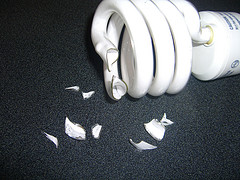Fluorescent Bulb Safety
Are CFL Bulbs a Health Hazard?
Now that incandescent lightbulbs have been phased out, energy-saving alternatives such as CFL (compact fluorescent) bulbs are in common use. But many consumers have questions about CFLs. Are CFL bulbs a health hazard? Do they contain toxic material? What happens when they break?
CFL Bulbs & Mercury: Is There a Risk?
You may have heard that CFL bulbs contain mercury — which is true. However, CFL bulbs emit less mercury than the old incandescent light bulbs, 2.4 mg compared to 10 mg over the same time period. (However, incandescent light bulbs contained no mercury, and this figure comes from the fossil fuels used to make the bulb.)
The mercury stored in the fluorescent lights is perfectly safe unless the glass is somehow damaged; in such a case, the bulbs can emit mercury vapor, which may cause poisoning if not dealt with quickly and properly. Keep in mind that the mercury in one light bulb usually isn't enough to harm you since it is spread throughout the room slowly over time.
What to Do if Your CFL Bulb Breaks
Remember that it is rare for a CFL to break because it is made with a higher quality glass that is much harder to break than incandescent lights. If one should happen to break, clean up following these steps to ensure your health and your family's health:
- Don't allow children or pregnant women into the area.
- Open the window to admit airflow into the room, which will allow the mercury vapor to dissipate.
- Sweep up the glass and phosphor powder. DO NOT vacuum it.
- Wipe the area with a damp paper towel to pick up stray particles of glass; place all the shards and the paper towel in a plastic bag.
- Take the sealed bag of glass, powder and paper towels to your local hazardous waste collection center.
Do CFLs Emit Ultra Violet (UV) Light?
Yes, CFLs emit small amounts of UV light. Manufacturers claim there is no health risk for the average person, as eight hours of exposure to CFL UV light is about the same as one minute in full sunlight.
However, some international studies revealed that even small amounts of CFL UV light can aggravate symptoms in chronic actinic dermatitis (where the skin becomes inflamed after reacting to sun or artificial light) and solar urticaria (a rare condition in which exposure to UV light induces hives on both covered and uncovered skin).
For the general population, in order to prevent risks of skin and retinal damage, researchers suggest avoiding CFL exposure at distances less than 12 inches. There is no cause for concern regarding skin cancer.
Blue Light Radiation, Flicker, Hums, Electric Magnetic Fields (EMF)
These issues are associated with older fluorescent lights and affected people with conditions including epilepsy, lupus, and autism. According to the experts, newer CFLs no longer pose a hazard.
Recycle CFL Bulbs
It’s important to recycle CFL bulbs once they no longer work. Just remember that CFLs contain mercury and should be recycled carefully to avoid contaminating the earth or water. Don’t just place them together with your regular household recycling for pickup, but take them to a center specially designated by your local government. Also, remember that some of the packaging on light bulbs says nothing about the light bulbs containing mercury.
Unsure about the bulbs you are currently using? Check with a qualified electrician, who will help determine whether you are using the best light bulbs for your home.
Updated October 7, 2018.
Looking for a Pro? Call us (866) 441-6648

Electrical Average Costs
Electricians Experiences

Replacement Of A Light Fixture That Literally Fell Off The Ceiling

Electrician Restarted The Lights In My Outdoor Kitchen




